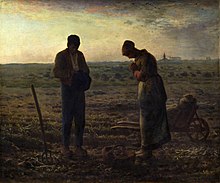
Back صلاة التبشير Arabic Məlaikə namazı Azerbaijani Añjeluz Breton Àngelus Catalan Anděl Páně Czech Aniół Pańsczi CSB Der Engel des Herrn German Anĝeluso Esperanto Ángelus Spanish Angelus Basque

| Part of a series on the |
| Mariology of the Catholic Church |
|---|
 |
|
|
The Angelus (/ˈændʒələs/; Latin for "angel") is a Catholic devotion commemorating the Incarnation of Christ. As with many Catholic prayers, the name Angelus is derived from its incipit—the first few words of the text: Angelus Domini nuntiavit Mariæ ("The Angel of the Lord declared unto Mary"). The devotion is practised by reciting as versicle and response three Biblical verses narrating the mystery, alternating with the prayer "Hail Mary". The Angelus exemplifies a species of prayers called the "prayer of the devotee".[1]
The devotion is traditionally recited in Roman Catholic churches, convents, monasteries and by the faithful three times a day:[2] in the morning, at noon and in the evening (usually just before or after Vespers). The devotion is also observed by some Western Rite Orthodox, Lutheran, and Anglican churches.[3]
The Angelus is usually accompanied by the ringing of the Angelus church bells, which is a call to prayer and to spread goodwill to everyone. The angel referred to in the prayer is Gabriel, a messenger of God who revealed to the Virgin Mary that she would conceive a child to be born the Son of God (Luke 1:26–38).[4] In Eastertide, the Angelus is replaced by the Regina Coeli.
- ^ Zaleski, Philip (2005). Prayer: a history. p. 128. ISBN 0-618-15288-1.
- ^ "Angelus". Preces-latinae.org. Retrieved November 23, 2017.
- ^ Masheck, Joseph (June 15, 2023). Faith in Art: Religion, Aesthetics, and Early Abstraction. Bloomsbury Publishing. p. 26. ISBN 978-1-350-21698-3.
Here Kadinky refers to the Angelus, a brief devotion sometimes used in the Anglican or Lutheran churches as well as the Catholic; practiced wherever out of doors one happens to be, it is signaled by the ringing of a church bell, and involves recalling the annunciation by saying the Ave Maria and a special prayer.
- ^ Luke 1:26–38
© MMXXIII Rich X Search. We shall prevail. All rights reserved. Rich X Search